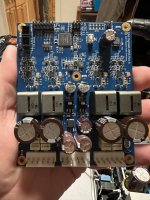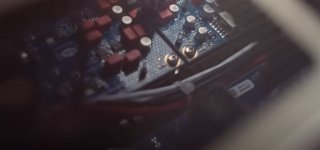Clearly, 8 more.Surely not.
24 bits is only 16 more than the signal, so you can't reduce to a low level before compromising source material.
The dynamic range of a 24 bit signal is not the issue, however linear or balanced the control is compared to an analog pot.
32 would be OK, I believe.
Not everyone lives alone, in a detached property, and has a big room.
Yes from what I've read the GaN output stage themselves the way Peachtree use them are analog, but because of their far superior switching speed and dead time figures, they allow the use of "everything before them to be totally digital", which Mosfets can't from what I gather. (correct me if I've understood it wrong)
Cheers George
As I noted a few pages back, GaN devices have some advantages over standard devices, the issue is in the implementation- to date, they aren't being used at "superior switching speeds"- just the same speeds roughly that standard mosfets are used at, with perhaps an exception or two, certainly not by Peachtree. The other issue, as I have said, is load dependence when they are implemented open loop. Again, current state of the art class d amps, such as Hypex and Purifi, using standard mosfets, perform much better than all of the GaN amps because they are cleverly designed and implemented. Read the interviews with the folks at Purifi as to why they haven't switched to GaN.
Just wonder.Why would higher speed and smaller deadtime lead to lower distortion? That doesn't make sense to me.
But maybe I am missing something?
Jan
Can deadtime in class D be compared to the crossover distortion in AB amps?
Can switsching speed in Class D be compared to bandwith in class AB/A amp?
Thats my intuitive comparation between the two, but i'm not sure its a good one.
If you look at an digital PWM signal conditioner the input is resampled and requantisized.Surely not.
24 bits is only 16 more than the signal, so you can't reduce to a low level before compromising source material.
The dynamic range of a 24 bit signal is not the issue, however linear or balanced the control is compared to an analog pot.
32 would be OK, I believe.
Not everyone lives alone, in a detached property, and has a big room.
Så it is easy to expand the bitdepth to 32 bits or whatever
Then it is up to the timer freq and switching freq + dithering to define the real bit depth of the signal.
https://www.st.com/resource/en/appl...-32bit-arm-cortex-mcus-stmicroelectronics.pdf
https://www.st.com/resource/en/appl...urpose-and-lite-timers-stmicroelectronics.pdf
Så you dont have to implement the volume control on the input signal. Then you are wasting bits.
But of course I have not seen a amp with 1 bit noisefloor from a 24 bit signal. That would be S/N =-144 dB
Last edited:
Again. A PWM signal is analog, not digital.
I know, it's hard, those engineering types make all that funny stuff. 😎
Jan
I know, it's hard, those engineering types make all that funny stuff. 😎
Jan
H
HAYK
You have an excellent intuition.Just wonder.
Can deadtime in class D be compared to the crossover distortion in AB amps?
Can switsching speed in Class D be compared to bandwith in class AB/A amp?
Thats my intuitive comparation between the two, but i'm not sure its a good one.
The AD mod has too much bias. The BD mod no bias. My ABD mod has just the required bias.
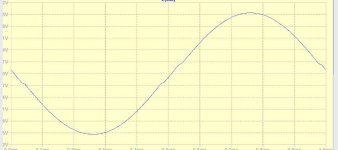
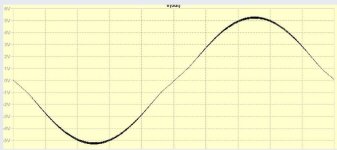
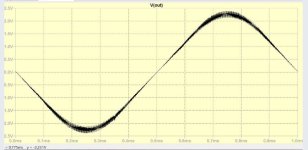
Last edited by a moderator:
Sure - but the amp linked by OP is just a power amp, and does not have variable gain, and it apparently is taking a 24 bit signal.Så you dont have to implement the volume control on the input signal. Then you are wasting bits.
H
HAYK
To transform the PCM to PWM in digital domain is not straight forward. Consider the PWM frequency of 100khz only, that is 10us wide. If the processor is running at 1Ghz, the minimum step is 1ns. The PWM then can be modulated 10,000 steps, this is less than 14bits definition. This why delta-sigma is applied to average the truncated data and get to hardly 16bit definition.
An amplifier with no feedback has a Zout which is often at the same order of magnitude or higher than the intended load impedance.
That makes the output voltage load dependent.
Just those 3 words makes that an assumption not a measured fact, until that happens with these 2 Peachtree amps we'll never know.
Cheers George
It does, but using the example of a COTS microprocessor to try and define resolution limits on a PCM to PWM conversion is a little daft. Take for example the mola mola tambaqui. That resamples incoming PCM to 3.125MHz 32 bit then does a PWM conversion with the data being clocked out at 100MHz. Bruno and co chose the right tools for the job in hand. He also did state at the time that doing PCM to PWM conversion in a power amplifier is a daft thing to do. One can chose to believe him or to think he has a vested interest in a particular implementation of class D. I know which I find more convincing.ASICS still has to obey time...
//
Apples v oranges. The GaN 400 has global feedback the GaN-1 and Carina-GaN have no feedback.Well the GaN400 shows significant frequency deviation dut to load, so why is this different?
And if you look at the two boards they are totalaly different to look at even though the 400 was taken through the case top vents, so that "call" just can't be made "yet".
Cheers George
Attachments
NO that wasn'nt said!so removing feedback will decrease output impedance?
They (Gan-1 and Carina-GaN) are totally different boards as I've showed you to what you are trying to compare them to the older GaN400, who knows what they've done, you can't speculate and put ****on them yet, till some measured figures come out on the way they've used them.
Cheers George
says the man whose initial post on this thread was full of speculation...
Good point.Sure - but the amp linked by OP is just a power amp, and does not have variable gain, and it apparently is taking a 24 bit signal.
To me it is scary to go all digital because of errors in datastream can destroy the speaker.
But as long it is not heavy digital filtering in the power amp, it should not be a problem with low sample depth.
The outside digital volume control could also implement dithering and other noiseshaping as it accept 192Khz signal.
192 to 48KHz is already 2 extra bits even with flat noise. Så then we are at -144dB -12dB = -156dB
As of now here are no "sample perfect" digital power amps anyways.
No need for forums if we can't speculate. Most of the fun is to try to call a bluff from a producer or designer. My 2 centssays the man whose initial post on this thread was full of speculation...
An interesting take on feedback and complex load in last part of this infomercal : https://www.axign.nl/news/ensuring-audio-quality-with-post-filter-feedback/
They make this the digital part of this: https://audioxpress.com/news/gan-sy...w-class-d-heatsinkless-audio-amplifier-design
" For example: the feedback loop assumes the ‘outside world’ to behave in a certain way, based on calculations and measurements. If the outside world (particularly the output filter) deviates greatly from that prediction, the high-order feedback loop can become unstable. The aggressiveness and effectiveness in the designs of our feedback loops are limited by this principle. In the far future, we will be measuring back the ‘outside world’ to adjust the loop."
So interesting to see if the amp of the OP has solved this already and is independent of the load
They make this the digital part of this: https://audioxpress.com/news/gan-sy...w-class-d-heatsinkless-audio-amplifier-design
" For example: the feedback loop assumes the ‘outside world’ to behave in a certain way, based on calculations and measurements. If the outside world (particularly the output filter) deviates greatly from that prediction, the high-order feedback loop can become unstable. The aggressiveness and effectiveness in the designs of our feedback loops are limited by this principle. In the far future, we will be measuring back the ‘outside world’ to adjust the loop."
So interesting to see if the amp of the OP has solved this already and is independent of the load
- Status
- Not open for further replies.
- Home
- Amplifiers
- Class D
- Peachtree new GaN-1 all "Digital Amplifier" the future?? (and it's not Class-D)
